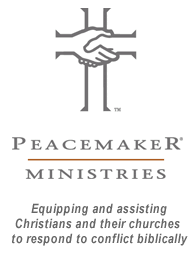 I would recommend that every church at least be familiar with Peacemaker Ministries and the resources that they offer. I recently had an opportunity to lead a group through their small-group DVD set and study guide, and the feedback was very encouraging, with tangible fruit produced.
I would recommend that every church at least be familiar with Peacemaker Ministries and the resources that they offer. I recently had an opportunity to lead a group through their small-group DVD set and study guide, and the feedback was very encouraging, with tangible fruit produced.
They have a church resource set, which contains posters, sermon outlines, a DVD, leader’s guide, and small-group participants’ guides. This is a great way to introduce a “culture of peacemaking” throughout the church. A newer resource is a DVD-based group study designed specifically church leadership teams, called The Leadership Opportunity: Living Out the Gospel Where Conflict and Leadership Intersect.
Here are some free online resources that give you an idea about their approach:
-
Getting to the Heart of Conflict – Conflict starts in the heart. Therefore, if we fail to address the heart in a conflict, then any solution will fall short of true reconciliation.
-
The Four G’s – The biblical system for resolving conflict is captured by “The Four G’s”: Glorify God, Get the log out of your own eye, Gently Restore, and Go and be reconciled.
-
The Slippery Slope – A visual tool for understanding the ways people tend to and ought to respond to conflict.
-
The Seven A’s of Confession – A guide to making a sincere and complete confession.
-
The PAUSE Principle – A biblical approach to negotiation.
-
The Four Promises of Forgiveness – A great way to remember what you are really saying (and committing to) when you say “I forgive you.”
-
The Peacemaker’s Pledge – Complete summary of biblical peacemaking, suitable for churches or organizations to commit to together.
-
Relational Commitments – A way for a church to make a mutual commitment to work together to pursue unity, maintain friendships, preserve marriages, and build relationships that reflect the love of Christ.
-
The Gospel of Peace Mirrored Through Peacemaking – A summary statement of how the gospel of Jesus Christ is at the core of biblical peacemaking.
Let me give you a quick outline of one of these resources (go here for the full version). They talk about The Slippery Slope, a very helpful visual for thinking about the different ways we can and should respond to conflict:
Escape Responses
On the left side are three responses typically used by those who want to avoid or get away from conflict instead of resolving it. Starting with the most extreme, they are:
- Suicide
- Flight
- Denial
Attack Responses
On the other side of the slippery slope spectrum are attack responses, going to the most extreme:
- Assault
- Litigation
- Murder
Peacemaking Responses
In the middle are responses of conciliation, recognizing that the gospel is the key to peace.
The six responses are divided into two categories:
Personal peacemaking:
- Overlook an offense
- Reconciliation
- Negotiation
Assisted responses
- Mediation
- Arbitration
- Accountability
Again, I find these sorts of tools very helpful for providing a grid of responses to conflict.
If you’re looking for helpful books applying peacemaking to various roles and aspects of life, here is what WTS Books carries:
- Ken Sande, Peacemaker: A Biblical Guide to Resolving Personal Conflict, 3rd ed.
- Alfred Poirier, The Peacemaking Pastor: A Biblical Guide to Resolving Church Conflict
- Tara Klena Barthel and Judy Dabler, Peacemaking for Women: Biblical Hope for Resolving Conflict
- Ken Sande with Tom Raabe, Peacemaking for Families: A Biblical Guide to Managing Conflict in Your Home
- Ken Sande and Kevin Johnson, The Peacemaker Student Edition: Handling Conflict without Fighting Back or Running Away
- Corlette Sander, The Young Peacemaker: Teaching Students to Respond to Conflict in God’s Way



















